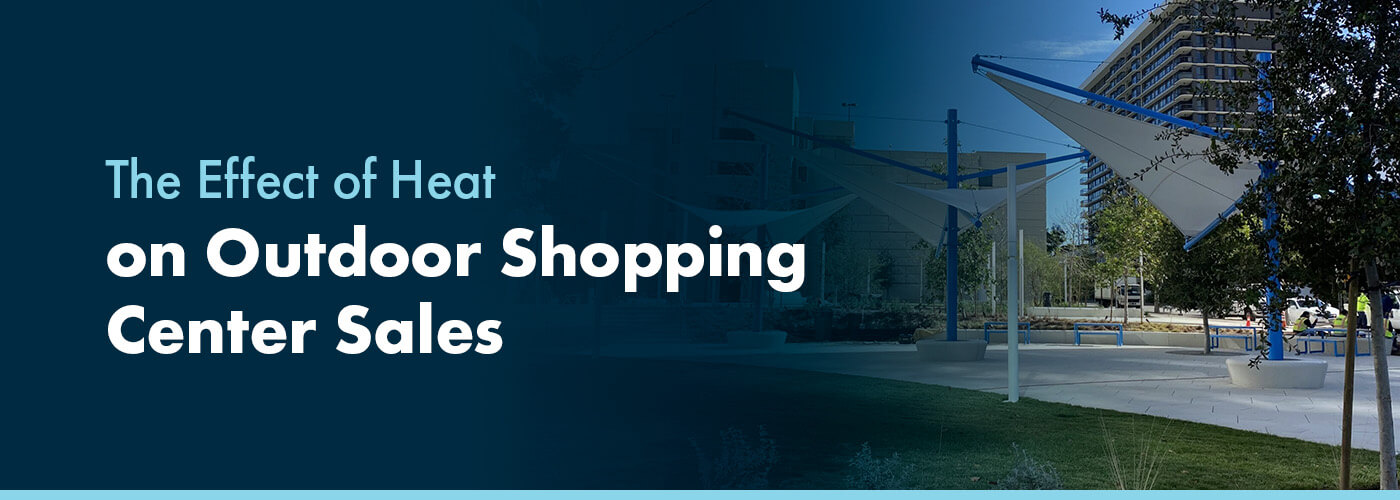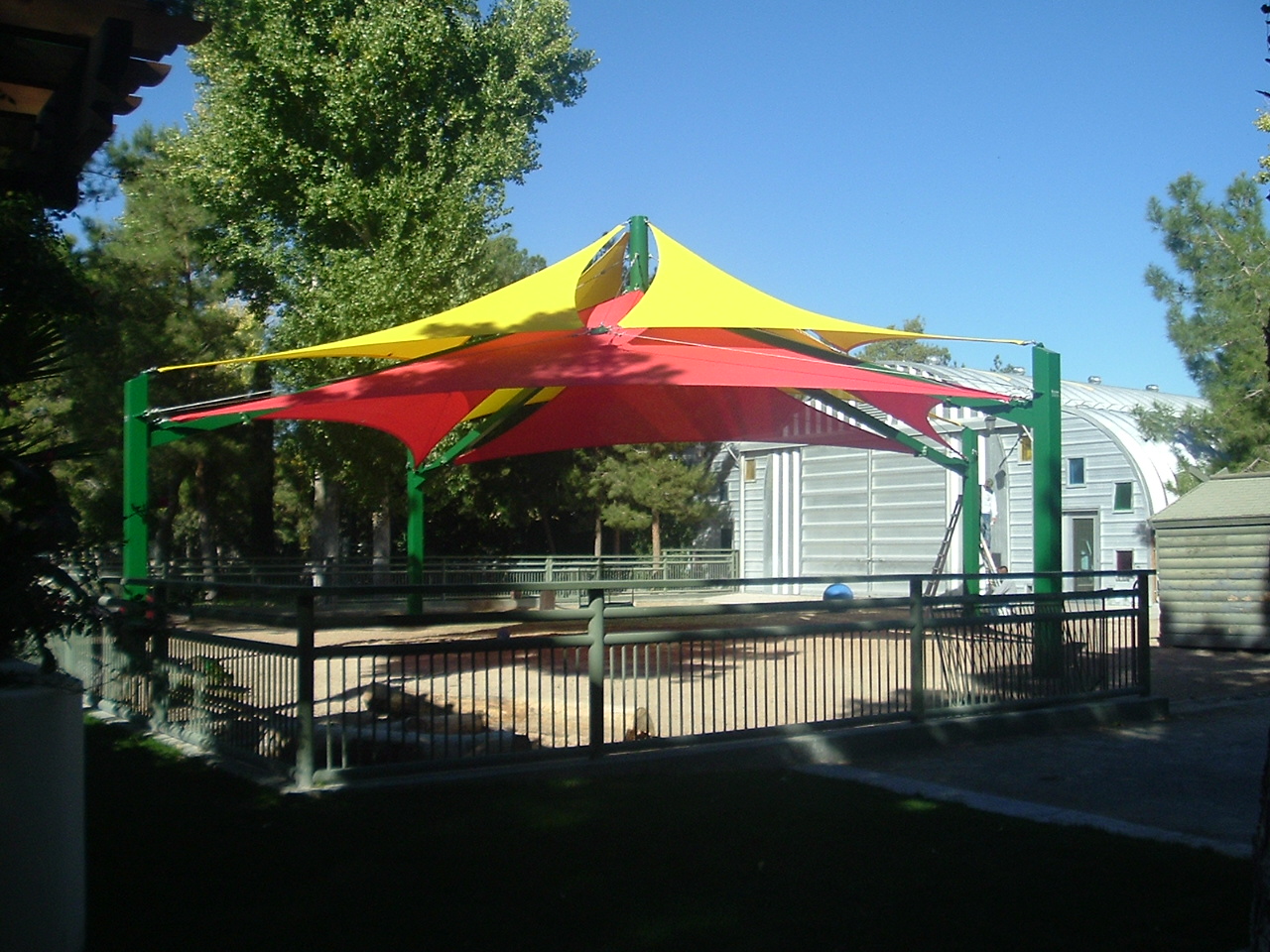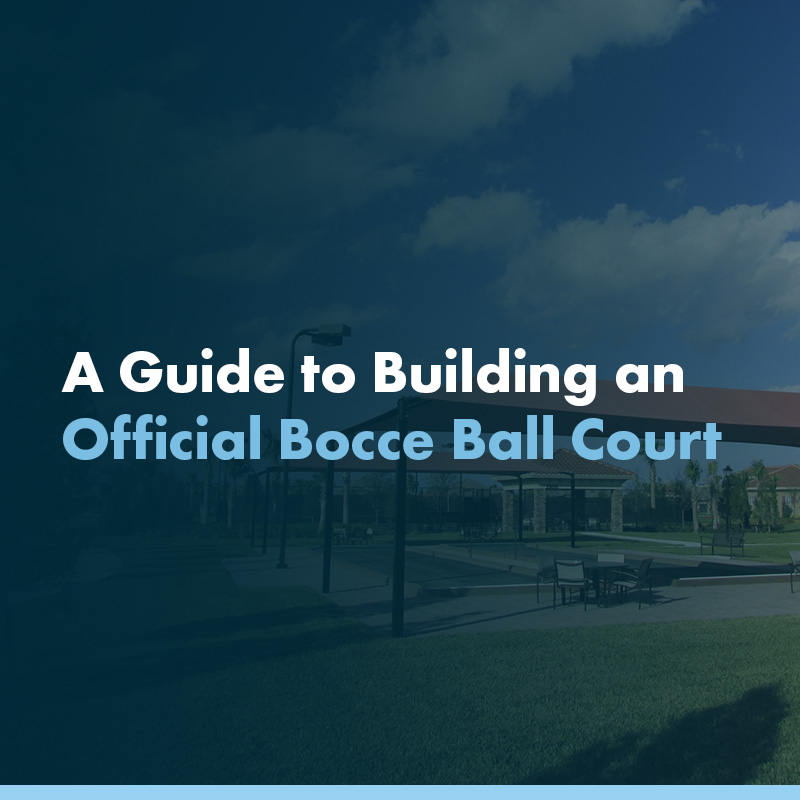
Outdoor malls have become increasingly popular shopping destinations, offering customers an open-air ambience while they shop. However, these spaces face a significant challenge — weather.
As temperatures soar, shoppers seek refuge from the sun, leading to decreased foot traffic and potentially substantial revenue losses. To keep patrons safe and comfortable and encourage shopping despite the heat, outdoor shopping malls need creative solutions that transform these spaces.
How Do High Temperatures Impact Outdoor Malls?
The scorching heat poses various challenges for outdoor mall operators, including:
Reduced Customer Comfort
When temperatures rise, the appeal of outdoor shopping can quickly diminish. The decline in the desire to be outside represents a substantial blow to businesses that rely on consistent customer flow, like outdoor shopping malls.
When faced with the choice between braving the heat for a shopping excursion or staying in air-conditioned comfort at home or an indoor mall, many consumers choose the latter. For those who venture out, the heat limits the length of their trips.
Increased Health Risks for Customers
Beyond mere discomfort, high temperatures in outdoor shopping environments pose potential health risks to visitors. The high heat is particularly concerning for vulnerable populations such as older adults, young children and those with preexisting medical conditions. Heat exhaustion is a serious concern in outdoor environments. Symptoms can range from excessive sweating and dizziness to rapid heartbeat and fainting. In extreme cases, prolonged exposure to high temperatures can lead to heat stroke, a potentially life-threatening condition.
Ultraviolet (UV) light exposure is often overlooked as a health concern in outdoor retail spaces. Prolonged sun exposure without adequate protection can lead to sunburn in the short term and increase the risk of skin cancer in the long term. Dehydration is another significant risk, especially in outdoor shopping malls where visitors may forget to hydrate regularly. Dehydration effects can set in quickly, leading to fatigue, headaches and impaired decision-making — none of which contribute to a positive shopping experience or encourage prolonged stays.
Decreased Sales
While the impact of high temperatures on outdoor mall sales isn’t uniform across all businesses, it’s significant. According to a 2024 study, extreme heat reduces activity by up to 10% in rural areas and 5% in urban settings — the hotter it gets, the less people want to move around, especially outside. For businesses based outside, that lack of activity can have many repercussions.
Some sectors feel the loss of sales more acutely than others. Apparel retailers often see the sharpest decline during heatwaves, as trying on clothes in stuffy fitting rooms becomes unappealing. Restaurants with outdoor seating areas can be empty in intense heat. Beauty and cosmetics retailers may also experience dips in foot traffic and sales during heat waves, as high temperatures and makeup don’t mix well.

How Shade Structures Can Help Outdoor Malls Combat the Heat
Outdoor mall operators don’t have to grapple with the challenges of high temperatures — shade structures offer the ideal solution. These architectural elements block the sun and create comfortable microclimates that can reduce ambient temperatures. The integration of shade structures into outdoor mall design yields many benefits, including:
- Better customer experience: Shade structures create comfortable, protected spaces, transforming how shoppers interact with and enjoy the mall. With reduced ambient temperatures under well-designed shade structures, shoppers can browse, dine and socialize without the discomfort of direct sun exposure or excessive heat. Innovative and visually striking shade solutions can become iconic mall features, creating spaces that attract visitors and encourage social media sharing.
- Increased foot traffic and sales: Shade structures can increase foot traffic by creating a more inviting environment, even during the hottest months of the year when outdoor malls struggle. Enhanced comfort leads to longer visit durations as customers are more likely to linger in a pleasant environment. Customers who can browse comfortably for longer tend to spend more money. They’ll enjoy the attractions, make impulse purchases and eat at the mall or buy takeout from restaurants and cafes.
- Safety and well-being: Beyond comfort and sales, shade structures are critical in creating a safer shopping environment. They provide UV protection, allowing shoppers to spend extended time without worrying about sun damage. Shade structures also reduce ambient temperatures, minimizing the risk of heat exhaustion and heat stroke among shoppers and staff. The safer environment reduces the likelihood of heat and UV-related medical emergencies that could negatively impact mall operations.
- Enhanced design and brand positioning: Well-designed shade structures become signature elements of an outdoor mall’s design, enhancing its visual appeal and brand positioning. They’re architectural focal points, adding visual interest and creating memorable landmarks that define the mall’s identity. These distinctive features can set a mall apart from competitors, positioning it as a modern, thoughtfully designed destination that prioritizes customer comfort and experience.
- Greater sustainability and energy efficiency: By naturally cooling outdoor areas, shade structures can decrease the energy needed for air conditioning in adjacent buildings and stores. For example, shade designs with solar panels provide clean energy for the mall. It’s also possible to incorporate air flow systems, such as outdoor fans, alongside shade structures to create the most comfortable experience.
- Increased property values: Stores located in shaded, high-traffic areas often command premium rents, increasing property value. The improved comfort, higher foot traffic and enhanced aesthetics make these locations more desirable for high-end retailers and popular brands, enhancing the mall’s prestige and profitability.
Options for Outdoor Shopping Malls
From sleek, modern designs to more traditional styles, there’s a shade solution for every outdoor shopping mall. Some top shade structure options include:
- Permanent structures: Shade structures like tensile membrane canopies combine form and function, creating sweeping covers that span large areas without intermediate supports. These are ideal for central plazas or food courts, providing expansive shade while serving as iconic mall features.
- Rigid panel systems: These structures offer a more solid feel and can seamlessly complement existing architecture. They’re particularly effective for creating covered walkways between buildings, ensuring continuous shade for shoppers moving from store to store.
- Retractable structures: Retractable awnings are excellent for storefronts or outdoor dining areas, allowing businesses to adjust to changing sunlight patterns or weather conditions. Motorized shade sails can be extended or retracted based on the sun’s position, offering optimal shade throughout the day while maintaining an open, airy feel when retracted.

Where to Place Shade Structures in Outdoor Shopping Areas
Properly designed and strategically placed shade structures are the perfect solution to scorching heat. Thoughtful design can maximize their impact on comfort and sales. Here are different ways your business can implement shade structures around the mall:
- Parking lots: Parking spaces are often customers’ first point of contact and can benefit greatly from shade structures. Large canopy structures covering multiple parking rows protect vehicles and provide a comfortable transition for shoppers. Some innovative designs incorporate solar panels, combining functionality with sustainability.
- Entrances and exits: These areas should feature overhead canopies or awnings, providing immediate relief from the sun and creating a welcoming transition into the outdoor shopping mall. Shade structures at entrances and exits can also serve as landmark features, enhancing the mall’s aesthetic appeal.
- Walkways and common spaces: Larger multi-panel shade structures that span vast areas can provide continuous shaded paths, while fabric canopies add a touch of color and style. These shaded corridors protect shoppers from the sun and create pleasant spaces for rest and social interaction.
- Seating areas: Add shade structures to seating areas to encourage shoppers to take breaks and potentially increase their time at the mall. Flexible, movable umbrellas and large canopies covering dining areas and benches are ideal options.
- Play areas: Add shade structures to play spaces to keep children and parents comfortable and safe from UV rays and encourage longer stays. Tensile structures or shade sails offer a playful and colorful look that children will love.
- Event spaces: Hosting outdoor events during hot weather can be tricky. Shade structures increase the mall’s utility and attractiveness for special occasions during warm, sunny weather. Large modular structures are the ideal option for versatile event areas, as they can be adapted based on the size and type of event.
- Storefronts: Add shade structures to outdoor mall storefronts to make them more comfortable for shoppers browsing and draw them inside. Awnings or smaller canopies that complement individual architectural styles provide a cohesive look while offering shade at the entry point.
By carefully considering the types and placement of shade structures throughout the outdoor mall, owners and managers can create a comprehensive shade strategy that enhances comfort, encourages longer visits and boosts sales across all shopping center areas.
Implementing Effective Shade Structures in Outdoor Malls
The successful integration of shade structures into an outdoor mall requires careful planning.
Designs and Materials
Choosing the right combination of design elements and materials is essential for creating shade solutions that are functional and visually appealing.

High-performance fabrics like polytetrafluoroethylene and ethylene tetrafluoroethylene offer excellent UV protection and durability, making them ideal for long-term outdoor use. These materials are also lightweight, allowing for more expansive and creative designs. Some fabric options are waterproof, offering protection from sun and rain, which can extend the usability of outdoor spaces during various weather conditions.
Color choices also affect aesthetics and functionality. Lighter colors reflect more sunlight, potentially creating a cooler environment underneath the shade structure. However, darker shades can create a more dramatic appearance and may be preferred in specific design contexts. Color choice should balance thermal performance with the desired visual impact and the outdoor mall design theme.
The shade structures’ shape and angle influence air circulation and heat dispersion. Designs that promote natural airflow can enhance shoppers’ comfort levels. For larger areas, including fans or other ventilation systems in the shade design can improve air circulation, creating a more pleasant environment even on the hottest days.
Integration With Architecture
Shade solutions should look like intentional outdoor mall design features, not afterthoughts. When selecting shade structures, consider surrounding buildings, using compatible materials or design motifs that reflect the mall’s existing appearance.
Flexibility is another key consideration in architectural integration. Modular or adaptable shade systems allow for changes as the outdoor mall evolves, ensuring the shade structures can be modified or expanded to meet changing needs. Retractable options offer versatility for different seasons or events, allowing the mall to adjust based on weather conditions or special occasions.
Incorporating lighting shade structures can extend their utility into evening hours, creating ambience and extending shopping hours during cooler parts of the day. LED options can provide energy-efficient illumination and offer color-changing effects for special events or seasonal displays.
Sustainability
Shade structures offer numerous opportunities to enhance an outdoor mall’s sustainability profile. Energy efficiency is a primary benefit of well-designed shade structures. By reducing the heat load on surrounding buildings, shade structures can decrease the energy required for air conditioning. Advanced shade designs with solar panels can also provide clean energy for the mall.
Shade structures can contribute to water management. Certain designs can be engineered to collect and redirect rainwater, which the mall can use for landscaping and other nonpotable water needs within the mall, especially during hotter months. This approach conserves water and can help manage stormwater runoff, a necessary consideration in urban environments.
Opting for recyclable or recycled materials with low production and disposal environmental impact can reduce the ecological footprint of these installations. Selecting durable materials and construction methods can also increase longevity, reducing the need for frequent replacements and the associated resource consumption.
Boost Your Outdoor Mall Sales With USA SHADE Solutions
When temperatures rise, outdoor malls face unique challenges in maintaining customer comfort and driving sales. Implementing effective shade structures offers a powerful solution, transforming hot and humid spaces into inviting shopping areas. They enhance customer experience, boost foot traffic, increase sales and improve safety.
With over 25 years of industry expertise, USA SHADE is ready to help your business create beautiful, practical spaces through innovative fabric architecture. Our turnkey solutions, uncompromising quality and commitment to sustainability make us the ideal partner for elevating your outdoor mall design.
Explore our shade solutions — including our quick-ship products — and contact us today to transform your outdoor mall environment and drive your business forward!






